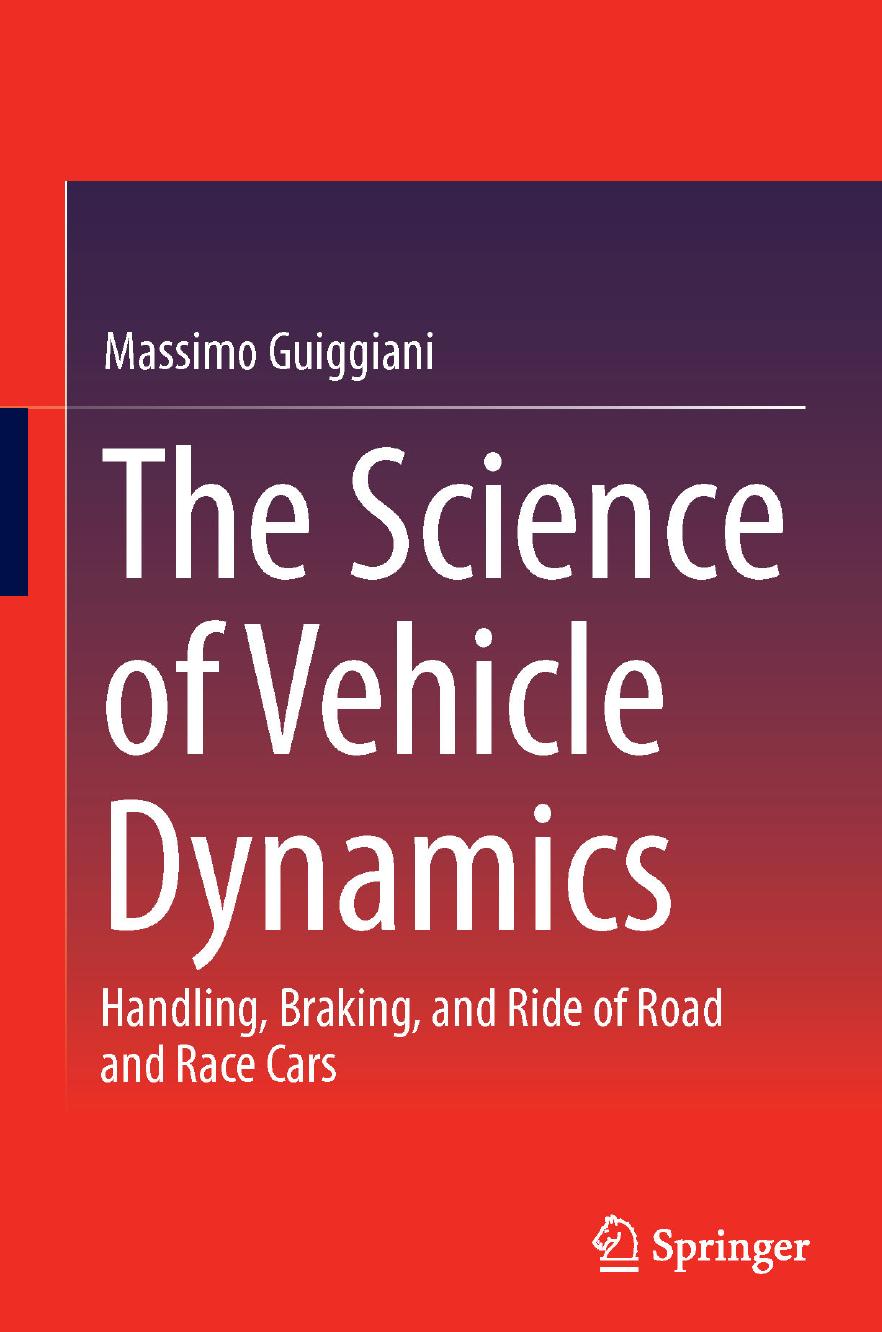The Science of Vehicle Dynamics Handling, Braking, and Ride of Road and Race Cars ( PDFDrive )


The Science of Vehicle Dynamics

Massimo Guiggiani
The Science of Vehicle
Dynamics
Handling, Braking, and Ride of Road
and Race Cars

Massimo Guiggiani
Dip. di Ingegneria Civile e Industriale
Università di Pisa
Pisa, Italy
ISBN 978-94-017-8532-7 ISBN 978-94-017-8533-4 (eBook)
DOI 10.1007/978-94-017-8533-4
Springer Dordrecht Heidelberg New York London
Library of Congress Control Number: 2013958104
© Springer Science+Business Media Dordrecht 2014
This work is subject to copyright. All rights are reserved by the Publisher, whether the whole or part of
the material is concerned, specifically the rights of translation, reprinting, reuse of illustrations, recitation,
broadcasting, reproduction on microfilms or in any other physical way, and transmission or information
storage and retrieval, electronic adaptation, computer software, or by similar or dissimilar methodology
now known or hereafter developed. Exempted from this legal reservation are brief excerpts in connection
with reviews or scholarly analysis or material supplied specifically for the purpose of being entered
and executed on a computer system, for exclusive use by the purchaser of the work. Duplication of
this publication or parts thereof is permitted only under the provisions of the Copyright Law of the
Publisher’s location, in its current version, and permission for use must always be obtained from Springer.
Permissions for use may be obtained through RightsLink at the Copyright Clearance Center. Violations
are liable to prosecution under the respective Copyright Law.
The use of general descriptive names, registered names, trademarks, service marks, etc. in this publication
does not imply, even in the absence of a specific statement, that such names are exempt from the relevant
protective laws and regulations and therefore free for general use.
While the advice and information in this book are believed to be true and accurate at the date of pub-
lication, neither the authors nor the editors nor the publisher can accept any legal responsibility for any
errors or omissions that may be made. The publisher makes no warranty, express or implied, with respect
to the material contained herein.
Disclaimer: This book is not intended as a guide for designing, building or modifying vehicles, and
anyone who uses it as such does so entirely at his/her own risk. Testing vehicles may be dangerous. The
author and publisher are not liable for whatsoever damage arising from application of any information
contained in this book.
Printed on acid-free paper
Springer is part of Springer Science+Business Media (www.springer.com)

Preface
Vehicle dynamics should be a branch of Dynamics, but, in my opinion, too often it
does not look like that. Dynamics is based on terse concepts and rigorous reasoning,
whereas the typical approach to vehicle dynamics is much more intuitive. Qualita-
tive reasoning and intuition are certainly very valuable, but they should be supported
and confirmed by scientific and quantitative results.
I understand that vehicle dynamics is, perhaps, the most popular branch of Dy-
namics. Almost everybody has been involved in discussions about some aspects of
the dynamical behavior of a vehicle (how to brake, how to negotiate a bend at high
speed, which tires give best performance, etc.). At this level, we cannot expect a
deep knowledge of the dynamical behavior of a vehicle.
But there are people who could greatly benefit from mastering vehicle dynam-
ics. From having clear concepts in mind. From having a deep understanding of the
main phenomena. This book is intended for those people who want to build their
knowledge on sound explanations, who believe equations are the best way to for-
mulate and, hopefully, solve problems. Of course along with physical reasoning and
intuition.
I have been constantly alert not to give anything for granted. This attitude has led
to criticize some classical concepts, such as self-aligning torque, roll axis, understeer
gradient, handling diagram. I hope that even very experienced people will find the
book interesting. At the same time, less experienced readers should find the matter
explained in a way easy to absorb, yet profound. Quickly, I wish, they will feel not
so less experienced any more.
Acknowledgments Over the last few years I have had interactions and discussions
with several engineers from Ferrari Formula 1. The problems they constantly have
to face have been among the motivations for writing this book. Moreover, their deep
knowledge of vehicle dynamics has been a source of inspiration. I would like to
express my gratitude to Maurizio Bocchi, Giacomo Tortora, Carlo Miano, Marco
Fainello, Tito Amato (presently at Mercedes), and Gabriele Pieraccini (presently at
Bosch).
I wish to thank Dallara Automobili and, in particular, Andrea Toso, Alessandro
Moroni, and Luca Bergianti. They have helped me in many ways.
v
 6
6
 7
7
 8
8
 9
9
 10
10
 11
11
 12
12
 13
13
 14
14
 15
15
 16
16
 17
17
 18
18
 19
19
 20
20
 21
21
 22
22
 23
23
 24
24
 25
25
 26
26
 27
27
 28
28
 29
29
 30
30
 31
31
 32
32
 33
33
 34
34
 35
35
 36
36
 37
37
 38
38
 39
39
 40
40
 41
41
 42
42
 43
43
 44
44
 45
45
 46
46
 47
47
 48
48
 49
49
 50
50
 51
51
 52
52
 53
53
 54
54
 55
55
 56
56
 57
57
 58
58
 59
59
 60
60
 61
61
 62
62
 63
63
 64
64
 65
65
 66
66
 67
67
 68
68
 69
69
 70
70
 71
71
 72
72
 73
73
 74
74
 75
75
 76
76
 77
77
 78
78
 79
79
 80
80
 81
81
 82
82
 83
83
 84
84
 85
85
 86
86
 87
87
 88
88
 89
89
 90
90
 91
91
 92
92
 93
93
 94
94
 95
95
 96
96
 97
97
 98
98
 99
99
 100
100
 101
101
 102
102
 103
103
 104
104
 105
105
 106
106
 107
107
 108
108
 109
109
 110
110
 111
111
 112
112
 113
113
 114
114
 115
115
 116
116
 117
117
 118
118
 119
119
 120
120
 121
121
 122
122
 123
123
 124
124
 125
125
 126
126
 127
127
 128
128
 129
129
 130
130
 131
131
 132
132
 133
133
 134
134
 135
135
 136
136
 137
137
 138
138
 139
139
 140
140
 141
141
 142
142
 143
143
 144
144
 145
145
 146
146
 147
147
 148
148
 149
149
 150
150
 151
151
 152
152
 153
153
 154
154
 155
155
 156
156
 157
157
 158
158
 159
159
 160
160
 161
161
 162
162
 163
163
 164
164
 165
165
 166
166
 167
167
 168
168
 169
169
 170
170
 171
171
 172
172
 173
173
 174
174
 175
175
 176
176
 177
177
 178
178
 179
179
 180
180
 181
181
 182
182
 183
183
 184
184
 185
185
 186
186
 187
187
 188
188
 189
189
 190
190
 191
191
 192
192
 193
193
 194
194
 195
195
 196
196
 197
197
 198
198
 199
199
 200
200
 201
201
 202
202
 203
203
 204
204
 205
205
 206
206
 207
207
 208
208
 209
209
 210
210
 211
211
 212
212
 213
213
 214
214
 215
215
 216
216
 217
217
 218
218
 219
219
 220
220
 221
221
 222
222
 223
223
 224
224
 225
225
 226
226
 227
227
 228
228
 229
229
 230
230
 231
231
 232
232
 233
233
 234
234
 235
235
 236
236
 237
237
 238
238
 239
239
 240
240
 241
241
 242
242
 243
243
 244
244
 245
245
 246
246
 247
247
 248
248
 249
249
 250
250
 251
251
 252
252
 253
253
 254
254
 255
255
 256
256
 257
257
 258
258
 259
259
 260
260
 261
261
 262
262
 263
263
 264
264
 265
265
 266
266
 267
267
 268
268
 269
269
 270
270
 271
271
 272
272
 273
273
 274
274
 275
275
 276
276
 277
277
 278
278
 279
279
 280
280
 281
281
 282
282
 283
283
 284
284
 285
285
 286
286
 287
287
 288
288
 289
289
 290
290
 291
291
 292
292
 293
293
 294
294
 295
295
 296
296
 297
297
 298
298
 299
299
 300
300
 301
301
 302
302
 303
303
 304
304
 305
305
 306
306
 307
307
 308
308
 309
309
 310
310
 311
311
 312
312
 313
313
 314
314
 315
315
 316
316
 317
317
 318
318
 319
319
 320
320
 321
321
 322
322
 323
323
 324
324
 325
325
 326
326
 327
327
 328
328
 329
329
 330
330
 331
331
 332
332
 333
333
 334
334
 335
335
 336
336
 337
337
 338
338
 339
339
 340
340
 341
341
 342
342
 343
343
 344
344
 345
345
 346
346
 347
347
 348
348
 349
349
 350
350
 351
351
 352
352
 353
353
 354
354
 355
355
 356
356
 357
357
 358
358
 359
359
 360
360
 361
361
 362
362
 363
363
 364
364
1
/
364
100%